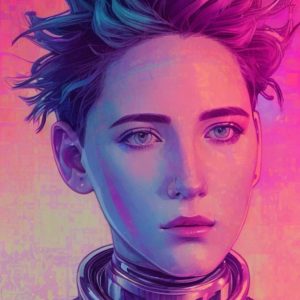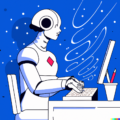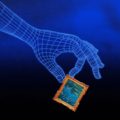
The photo that is used for this article is my sister, who in 2022, like many others quickly uploaded selfies of herself on an app called Lensa. Lensa is an AI-powered photo generator, that, like many others, allows the user to upload and enhance selfies that are designed to mimic pre-established, trending aesthetics. The beautification of the selfies inherently came along with backlash from the art world. Critics of AI art allege that these algorithms are stealing art from artists. In order to understand the perspective of many artists, it’s essential to understand how these apps generate artwork.
Starting from the base, the Oxford Dictionary defines an algorithm as “a process or set of rules to be followed in calculations or other problems.” In other words, Algorithms act as lists of instructions that AI uses to conduct specified actions, step by step. In the world of AI art, the artist maintains an active hand by inputting the instructions that AI uses as a road map to “learn” specific techniques and aesthetics of past examples. This is where the controversy comes into play. In order for artificial intelligence to create artwork, it first has to “learn.” AI artists write algorithms that incorporate already-made art by assembling a cohort of images to sustain the algorithm. This phase is referred to as the “pre-curation.” The artist must teach the algorithm how to comprehend the creative process that is used to create specific art. The algorithm can be tweaked in order to generate the desired output. Critics claim that the analytical process of creating AI art lacks intent, and creates work that appropriates the creative process of artists. Feeding the algorithm pre-existing artwork from various artists undermines the artist’s ability to consent to the use of copyrighted work, and there is no compensation for their involvement in teaching the AI how to generate profitable artwork. The mechanized blending together of AI artwork lacks depth but serves the purposes that consumers want.
When my sister used the Lensa app she paid four dollars, uploaded a couple of selfies, and in return, she received hundreds of AI-generated portraits within minutes, which speaks to the profound nature of Artificial Intelligence that separates itself from the intrinsic embodiment of the artistic element of intent- AI takes seconds, human artists take hours. The profound nature of AI is that it was derived from the neurological representation of the human brain. Although humans and artists learn about artistic styles in comparable ways, AI is capable of rapidly analyzing and learning from giant databases, something that human process is incapable of. These databases that AI learns from, in an artistic context, are other artists’ creations, consequently threatening opportunities for artists to create and charge a fair price for similar artworks. Therefore, using AI to generate art comes with moral and ethical weight, a weight that will become denser as society cultivates the use of AI to eliminate mundane tasks- slowly eroding creativity.




AI operates on an algorithm that relies on other artists’ works, and the AI artists seem to utilize other artists’ work without explicit consent. Thus, the overall methodology of AI creating its own art stems from stealing the art of real-life artists who put in their personal labor and time towards creating their personal art style/pieces. By profiting from incorporating artistic works that don’t belong to the AI artists, it is unfair to these individual artists who didn’t provide permission to have their works employed in such a way while also not receiving any monetary compensation. The AI’s art style can never truly be unique due to its foundation being built from multitudes of artists, so it can never fully replicate the individuality and creativity an individual human artist maintains.
AI art is truly impressive but does raise concerns of ethics. AI relies on the preexisting work of other artists, and will replicate what other people have spent their lives on crafting. Through this type of learning, it only learns how to copy and replicate a mixture of other artists hard works and styles, which then raises concern about who can “claim” the art. I think it will be slow but I do think that AI art will eventually replace human art. Through optimization of machine learning and algorithm planning, there definitely is potential that there can be a development in the creative processes in AI art that will eventually exceed and replace the need for human made art, which poses a risk for those in the profession of losing their jobs. For those concerned with this then will have to consider what sorts of rules and regulations should be imposed on AI as it is such a rapidly growing field of its own.
I think AI art needs specific regulations to regulate the use of AI paintings. Although AI paintings are more rigid and blurred than real painters, it is difficult for many people to perceive the difference. I have seen some people try to use the pictures drawn by AI to sell others as their own works. This is a great injustice to real artists. We need to formulate relevant regulations and measures to enable AI art to be applied within a reasonable range and to protect real artists’ rights and creative achievements.
I completely agree with the article’s viewpoint on AI-produced art. While there is no doubt that AI technology is advancing, there are ethical questions when it comes to the production of art. Real artists’ work is used as a foundation for AI algorithms, thereby hijacking their creative processes without their permission. Important considerations concerning who owns the art that is created as well as who should fairly compensate the creators whose work aids in the AI’s learning process are raised by this. I think that human-made art will always be superior to AI art. For artists, the creative process is a highly individualized and emotive journey, and it is the human touch that gives art its purpose and authenticity. While AI is capable of producing a large number of pictures quickly and replicating established styles, it is unable to fully express the profundity and substance of human creativity.
Before reading this article, I was impressed by AI “art” while firmly believing that it would never replace the artworks created by artists. However, I barely reflected on the formation of AI algorithms and the process behind the quick generation of art. I think it’s unfair for artists to appropriate tons of their previous artworks to write the algorithms and make a profit out of it. Besides the compensation, the developing AI “art” will also compete with human artists. There are many people who use AI art as their profile photos these days, and it’s undeniable that they are delicate and pretty. However, the creativity and efforts of the artists are severely hampered. Therefore, I think more efforts and attention should be placed on the protection of the artists’ rights and benefits.
I really agree with the article. The advancement of AI technology is undeniably impressive, but when it comes to creating art, it raises ethical concerns. AI algorithms rely on the work of real artists, essentially appropriating their creative process without their consent. This raises questions about the ownership and fair compensation for artists whose work contributes to the AI’s learning process. I believe that AI art will never replace human-made art. The creative process is a deeply personal and expressive journey for artists, and it’s the human touch that infuses art with meaning and authenticity. While AI can mimic pre-established aesthetics and churn out countless images in seconds, it falls short in capturing the essence and depth of human creativity.
As with a previous commenter, I am also an artist myself, and agree with the addition that the technology behind AI art is impressive. I do, however, worry about the ethical implications of AI art in the way it may displace human artists. I disagree that AI art is always easy to spot, while some pieces are obvious, others are less so, and I have seen several human artists be accused of using AI simply because they have an art style that is likely similar to the art being fed to those algorithms. Additionally, the algorithm is always learning, and while I doubt that human artists will be completely replaced, I do believe that AI will get better and better at producing art that is more difficult to distinguish from that of real people.
As an artist, I have very conflicting feelings surrounding the use of AI to create “art”. While the technology is definitely impressive, it “learns” by using real people’s hard work. In addition, I don’t think AI art will ever replace human made art; it just feels soulless and uncanny to me.
As an artist myself, I have very conflicting feelings surrounding AI “art”. While I admit the technology is impressive and we have come a long way in the scientific field, it “learns” by looking at real art that was made by human hands. If the AI had no real art fed into it, it probably would not produce such impressive looking images. I personally do not think it will ever replace real art made by humans, as AI art as of present is very easy to spot. It just feels soulless and artificial; it almost gives an uncanny feeling that real art does not.